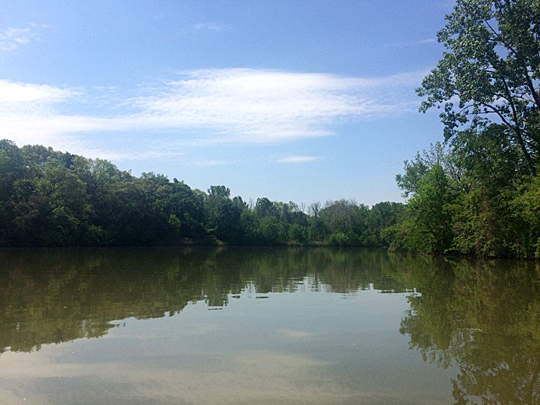A graduate student at The University of Toledo is the first researcher to find direct proof of grass carp, a type of invasive Asian carp, spawning in a Great Lakes tributary.
Holly Embke collected eight grass carp eggs last summer in the Sandusky River, which flows into Lake Erie. She discovered the eggs between Fremont, Ohio, and Lake Erie’s Sandusky Bay after a period of heavy rains.

UT graduate student Holly Embke is the first researcher to discover direct proof of grass carp, a type of invasive Asian carp, spawning in a Great Lakes tributary.
This research was conducted as a follow-up to U.S. Geological Survey findings in 2013 that indicated four young grass carp taken from the Sandusky River were the result of natural reproduction.
“Lake Erie commercial fishermen have reported catching grass carp since the mid-1980s, but those catches were thought to be sterile escapees from ponds and small lakes that were legally stocked for aquatic weed control,” said Embke, who is pursuing a master’s degree in biology in the Department of Environmental Sciences. “The discovery of these eggs in the Sandusky River means that this invasive species of Asian carp, which consumes large amounts of freshwater vegetation, is naturally reproducing in our Lake Erie watershed.”
Although considered a species of Asian carp, wild adult grass carp pose significantly different risks to the Lake Erie ecosystem than bighead carp and silver carp, which are the two invasive Asian carp species of great concern in the Mississippi River basin. Both bighead carp and silver carp consume plankton, and if these species were to make their way into the Great Lakes basin, they would compete for the same source of food that ecologically and economically important native fish species need to survive. Silver carp are well-known for their jumping ability.Grass carp pose a risk to waterfowl habitat and wetlands, but they do not eat plankton and are unlikely to compete directly with native fish. Grass carp do not jump and are primarily herbivorous. They can alter habitats for native fish communities near the shoreline by eating submerged, rooted plants and weeds.
Scientists with UT, the Ohio Department of Natural Resources Division of Wildlife and the U.S. Geological Survey are collecting additional samples from the Sandusky River to continue studying the habitat requirements of grass carp spawning in order to inform methods for control of all invasive species of Asian carp.
“While the discovery of eggs is disconcerting, grass carp continue to remain present in the Lake Erie system in very low abundance,” said Rich Carter, executive administrator for fish management and research with the Ohio Department of Natural Resources Division of Wildlife. “There is currently no evidence of negative impacts to the Lake Erie ecosystem that can be attributed to grass carp. However, it is important that we remain vigilant and continue to build understanding about this species in Lake Erie and throughout the Great Lakes.”“Given the similarities in reproductive strategies, this ongoing research on grass carp spawning may help us minimize the risk of bighead carp and silver carp from establishing a foothold in the Great Lakes,” said Patrick Kocovsky, a U.S. Geological Survey research fishery biologist. “What we learn here also might apply to potential control strategies in tributaries to the Mississippi River.”
Sterile grass carp can be legally stocked in Ohio, as well as Indiana, Illinois, New York and Pennsylvania. They are a popular pond and small lake management tool because they control aquatic weeds. Ohio has banned the stocking of fertile grass carp, and Michigan has banned all grass carp. The fish was first imported to the United States from Taiwan and Malaysia in 1963.

Last summer, UT graduate student Holly Embke collected eight grass carp eggs in the Sandusky River, which flows into Lake Erie.
“Predicting locations and conditions where grass carp spawning is most probable may aid targeted efforts at control,” Embke said.
Embke is based out of UT’s Lake Erie Center, where she does all of her sample processing and analysis.
The UT Lake Erie Center is a research and educational facility focused on environmental conditions and aquatic resources in Maumee Bay and western Lake Erie as a model for the Great Lakes and aquatic ecosystems worldwide.
“This discovery was student research,” Dr. Christine Mayer, UT ecology professor, said. “Our graduate students are doing work that is useful. They’re not just in the lab. They’re out in our region’s rivers and lakes providing information that helps solve problems.”
For more information on Asian carp or how to report sightings, go to wildlife.ohiodnr.gov.